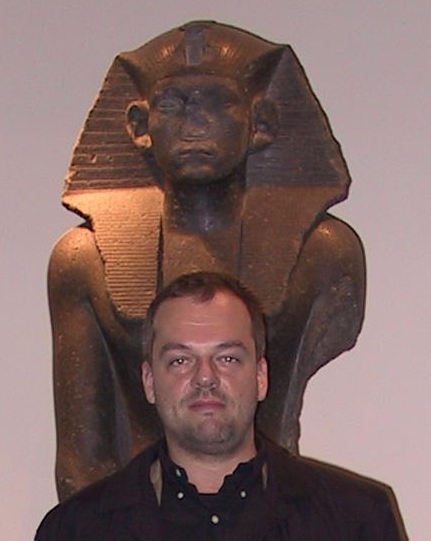 Dr. Walter Scheidel
Dr. Walter Scheidel
Ph.D. Candidate
Department of Classics
Stanford University
Stanford, CA 94305-2080
USA
Distinguished Speaker
Associate Professor
Department of Classics
Stanford University
Stanford, CA 94305-2080
USA
scheidel@stanford.edu
"Actually, no wheeling is more my speciality": Why Buffy Doesn't Drive
[Click on the link above to see this paper's placement in the SCBtVS Program.]
|
Buffy Summers may look like a typical Californian teenager, but there's something very, very strange about her: no, it's not the fact that she patrols for vampires and slays them; no, it's not the fact that she dates the undead on a regular basis. The strangest thing about Buffy is that she does not drive. Anyone who has ever lived in the concrete jungle of Southern California knows the vital role that automobiles play in autonomy, and anyone who has been a teenager understands what an important rite de passage driving constitutes. Nonetheless, in seven seasons Buffy never gets a driver's license and drives a whopping one time (when all the adults are mentally incapacitated, 3.6). As Buffy herself admits to Riley (4.9), "Cars and Buffy are, like, unmixy things." But why? Existing scholarship on the SoCal context of the Buffyverse has failed to consider this issue (e.g., Tonkin 2001). We address this problem on two levels. (A.) In the most general terms, Buffy's aggressive pedestrianism is emblematic of the incompatibility of magic and modern technology that pervades the entire series (cf. Wandless 2001; Aberdein 2003). Willow's transformation from computer nerd to wicca, Giles' technophobia, the failure of Jenny Calendar (1.8, 2.17), the Initiative (4.13-21), and the Trio/Troika (6.4-5,13,19) to contain the supernatural by scientific means or fuse the two spheres are among the many examples that could be cited. Pertinent studies focus on features such as robots and computers without critically engaging with the more conspicuous phenomenon of Buffy's shunning of California's car culture (Beeler 2002, Calvert forthcoming, Grossman forthcoming). (B.) However, to gain a deeper understanding of Buffy, "the avid pedestrian," one must more specifically consider two factors: (1) What major issues are at stake in episodes when Buffy fails to drive? and (2) If Buffy doesn't drive, who does and what does it mean? Upon inspection, three distinct patterns become clear. First of all, although Buffy fails to drive, the boys on the show are frequent motorists. Moreover, it seems that Oz's van, Giles' jalopy (and, later in the fifth season, his mid-life crisis mobile), Xander's subcompact (7.1), and Angel's convertible (as Lorne points out in Angel 2.13) are in essence extensions of themselves. Secondly, and yes, Buffy, this is "a penis metaphor" cars on Buffy have a great deal to do with sex. Buffy's picnic conversation with Riley about not driving (4.9) ends in Buffy tacitly accusing Riley that he drives recreationally because it is a surrogate for sex. Spike driving to win Drusilla back with reinvigorated confidence bordering on virility (3.8) is another case in point. Likewise, it seems no coincidence that the night that Xander borrows his Uncle Rory's car, he also ends up losing his virginity to Faith (3.13); indeed, not only does Xander 'become a man' (so to speak), but the night he has the car, he also becomes the hero who saves the day, zooming around Sunnydale in the car and fighting off a band of teenage zombies. In turn, Xander's automobile-enhanced character provides an interesting contrast to Buffy, whose inability to drive is either associated with her failure to win her mother's confidence (hence, why she is not allowed to drive in 3.6) or is reminiscent of her continual inability to gain access to the adult world (implied in 4.9 and a neat parallel to her misadventures in job-hunting in 6.5). Similarly, when Willow's inability to control magic is explored on the show, it is either indirectly paralleled to driving (such as 4.9, the episode wherein Buffy reveals to Riley her inability to drive, which appears to act as a foil to Willow's magic problems) or directly related to driving (such as the near-fatal car wreck in 6.10). These observations are not meant to diminish Buffy's power as a figure of feminine empowerment, but Buffy becomes a more interesting and nuanced character when we see that, although she can master weapons (or turn anything into a weapon), she still can't master the basics of Californian life. In creating the ultimate feminine icon, the writers of Buffy also find fascinating ways to explore her limitations by employing the age-old tropes surrounding boys and their cars.
References Aberdein, A. 2003 'Balderdash and chicanery: science and beyond.' In J.B. South (ed.), Buffy the Vampire Slayer and Philosophy, 79-90 (Open Court: Chicago & La Salle) Beeler, S. 2002 'Overloading the operator: computers, sex and magic', Paper given at Blood, Text and Fears Conference, University of East Anglia Calvert, B. forthcoming 'Going through the motions: robots in Buffy the Vampire Slayer.' Paper proposed for the Slayage Conference on Buffy the Vampire Slayer Grossman, J. forthcoming 'Spike, the Initiative, and the substitution of the technological for the metaphysical.' Paper proposed for the Slayage Conference on Buffy the Vampire Slayer. Tonkin, B. 2001 'Entropy as demon: Buffy in Southern California.' In R.Kaveney (ed.), Reading the Vampire Slayer, 37-52 (Tauris: London & New York) Wandless, W. 2001 'Undead letters: searches and researches in Buffy the Vampire Slayer.' Slayage 1. |